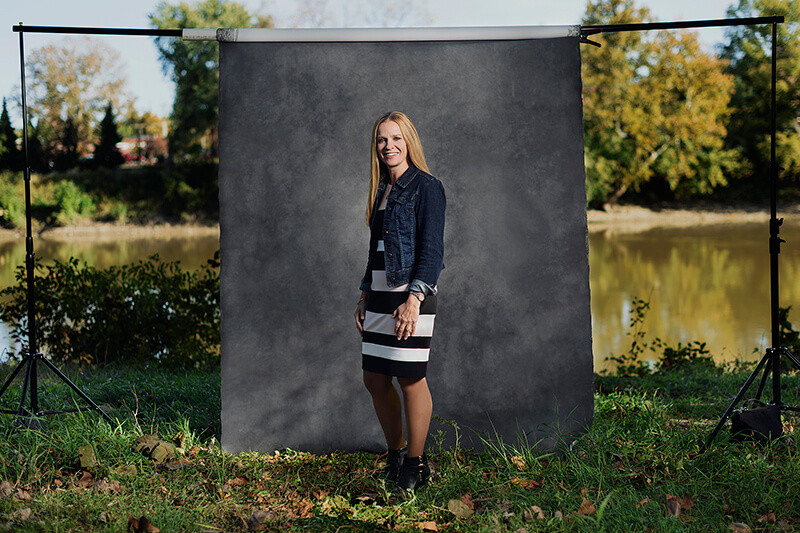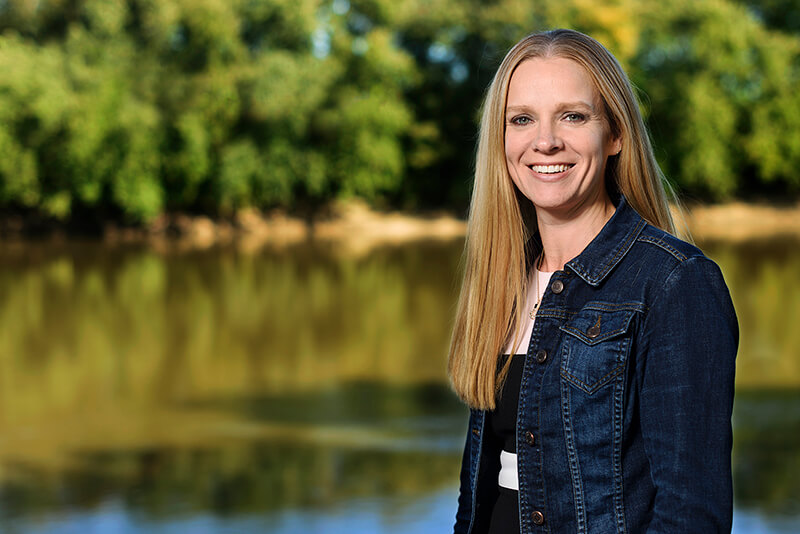October 31, 2018
How much danger are we in when chemicals are spilled in local rivers?

Jennifer Freeman, a Purdue University associate professor of toxicology, and her group conducted a toxicological assessment on the MCHM mixture that spilled in Elk River in West Virginia in 2014. (Purdue University Rebecca Wilcox)
“We have almost 90,000 chemicals currently in commerce, and … we have decent toxicology data for only a few hundred”
WEST LAFAYETTE, Ind. — When a chemical spill in Elk River contaminated the drinking water of nearly 300,000 West Virginians in 2014, little was known about the contaminant MCHM, a type of methanol used industrially for cleaning coal. But now that it was in a local water source … is it a safety issue? Would exposure harm brain development in children?
Jennifer Freeman, a Purdue University associate professor of toxicology, wanted to answer those questions, and her group conducted a toxicological assessment on the MCHM mixture that escaped Tank 396 that day.
 Jennifer Freeman is dedicated to improving the understanding of health risks associated with exposure to environmental contaminants such as MCHM, which is methylcyclohexanemethanol. (Purdue University Rebecca Wilcox)
Download image
Jennifer Freeman is dedicated to improving the understanding of health risks associated with exposure to environmental contaminants such as MCHM, which is methylcyclohexanemethanol. (Purdue University Rebecca Wilcox)
Download image
She is dedicated to improving the understanding of health risks associated with exposure to environmental contaminants such as MCHM, which is methylcyclohexanemethanol. The study, published last year, was the first to evaluate the potential health risks of the Elk River spill.
“With the chemicals we’re looking at today, the number one problem we are trying to address is understanding whether there is a health risk from exposure to certain environmental contaminants,” Freeman said. “We have almost 90,000 chemicals currently in commerce, and of that number we have decent toxicology data for only a few hundred.”
In her lab, Freeman studies an area of environmental toxicology known as the developmental origins of health and disease. She focuses on the adverse health outcomes throughout the lifespan from various levels of exposure to harmful chemicals during different stages of development.
“We look at whether the developmental chemical exposure may make an individual more susceptible to chronic diseases and other adverse health outcomes later in life using the zebrafish model system for translation to human health,” Freeman said.
Her health research aligns with Purdue's Giant Leaps celebration, acknowledging the university’s global advancements made in Health, Longevity and Quality of Life as part of Purdue’s 150th anniversary. This is one of the four themes of the yearlong celebration’s Ideas Festival, designed to showcase Purdue as an intellectual center solving real-world issues.
Freeman is focused specifically on contaminants of drinking water and their adverse effects. She wants people to have a better understanding of the chemicals they are exposed to in everyday life. Using a method called transcriptomics, which examines changes in the set of RNA molecules in an individual cell or a population of cells, she tracks how exposure can lead to changes in the genome. The zebrafish model allows her to see the effects of exposure over an organism’s lifetime.
“My main focus is on chemicals that contaminate our drinking water. There may be some toxicity information for these chemicals, but there are still questions surrounding our exposures,” Freeman said. “Our projects are looking at some agrochemicals that are used here in the Midwest, metals, and other legacy and emerging chemical contaminants.”
One of the main metals that Freeman works with is lead, highly toxic and known for causing adverse neurological effects. Young children are particularly vulnerable to experiencing effects from lead poisoning. But the lack of data on many environmental contaminants limits the ability to protect from potentially harmful exposure.
In her zebrafish models, Freeman is able to examine neurotoxicity and other adverse health outcomes such as cancer in hopes of better understanding - and ultimately preventing - exposure to environmental contaminants.
“For the toxicity data, we historically have looked at high concentrations to identify mechanisms, but we’re finding out that’s not necessarily the best approach. What we’re finding is that as we go lower in concentrations, we sometimes see different adverse health outcomes,” Freeman said. “We’re trying to understand the true meaning of what we’re exposed to today so that we can have a better understanding of what that exposure means for us.”
Freeman is in the School of Health Sciences, which is housed in the College of Health and Human Sciences.
Writer: Sarah Olsen
Media contact: Amy Patterson Neubert, 765-494-9723, apatterson@purdue.edu
Source: Jennifer Freeman, 765-494-1408, jfreema@purdue.edu
NOTE TO JOURNALISTS: “Comparative analytical and toxicological assessment of methylcyclohexanemethanol (MCHM) mixtures associated with the Elk River chemical spill” is the Elk River publication by Jennifer Freeman that is mentioned in this story. It was published in Chemosphere.

